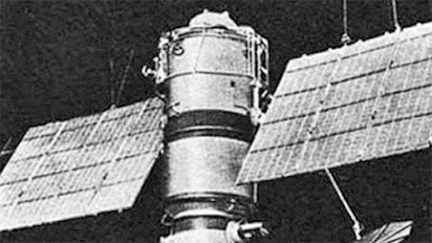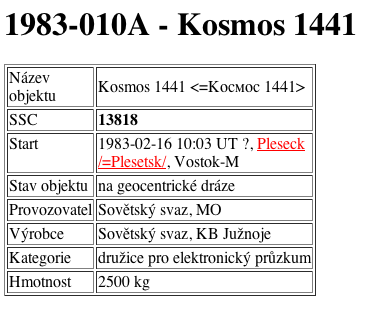.
7.11.2014
Soviet satellite Kosmos-1441 to burn in atmosphere November 8 — space defense spokesman
The satellite was launched by the USSR on February 16, 1983 with a Vostok rocket, its service life expired in February 1984
Russia’s Space Defense Force is keeping track of the Kosmos-1441 satellite, which is about to leave the orbit within hours, Space Defense Force spokesman Alexey Zolotukhin told TASS.
“Analysis indicates that fragments of the Kosmos-1441 satellite will leave the near-Earth orbit on November 8, 2014 over the Pacific Ocean. The final date and site where the fragments will be dumped may change under the influence of external factors,” he said.
Space Defense Force specialists are maintaining stable control of every single orbit.
Also, Zolotukhin confirmed the dumping of fragments of another space satellite — Kosmos 1939 on October 29 — over the Caribbean.
The Soviet Union launched the Kosmos-1441 satellite on February 16, 1983 with a Vostok rocket. Its service life expired in February 1984.
Quelle: TASS
.
One Down, One To Go, As Old Russian SpySats Turn Into Burned Objects


Image of the Kosmos-1441 satellite
[SatNews] The RT news site is reporting that an old Soviet reconnaissance satellite is due to enter and burn up in the Earth’s atmosphere on Saturday, November 8, 2014, while any possible debris is projected to fall into the Pacific Ocean, this according to the Russian Aerospace Defense Force.
“Analysis indicates that fragments of the Kosmos-1441 satellite will leave the near-Earth orbit on November 8, 2014 over the Pacific Ocean. The final date and site where the fragments may crash may change under the influence of external factors,” spokesman for the Russian Space Command Aleksey Zolotukhin told TASS.
Kosmos-1441 is a Soviet military ELINT (Electronic and Signals Intelligence) satellite that was launched from the Plesetsk cosmodrome in 1983 onboard a Vostok rocket. The satellite was a part of the Soviet and then Russian space-based military surveillance system, designed to detect radio-emitting objects, their type and mode of operation, including how active they are. Its one-year active service life is said to have expired in February 1984.
The Aerospace Defense Force specialists maintain stable control and are tracking the spacecraft, which is currently orbiting the Earth at 88 minutes orbit time, 81 degrees inclination, apogee 215 km, perigee 204 km. The agency also confirmed an earlier deorbiting of the Kosmos-1939, and that satellite fell into the waters of the Caribbean Sea, which occurred on October 29th.
Quelle: Satnews Daily
.
Update: 9.11.2014
.
MOSCOW, A defunct Soviet satellite has left the Earth's orbit, disintegrated and plunged into the Pacific as anticipated by the Russian Air Defense Forces, its spokesperson said Saturday.
"According to the Center for Space Monitoring at the Main Center for the Missile and Space Defense, the fragments of the space object left the orbit at 2:52 p.m. MSK [11:52 GMT] on November 8, 2014 over the Pacific Ocean," Col. Alexei Zolotukhin, a spokesperson for Russia's Aerospace Defense Forces said.
The satellite, identified as Kosmos-1441, was expected to make a comeback in early November, together with another obsolete Soviet satellite which veered off the course and plunged into the Caribbean Sea on October 29.
Kosmos-1441 was put into orbit on February 16, 1983 and stopped operation the next year. In 2009, another decommissioned Kosmos satellite collided with a US Iridium telecom satellite in the first ever high-speed crash between two man-made objects in space.
Quelle: RiaNovosti
4831 Views
